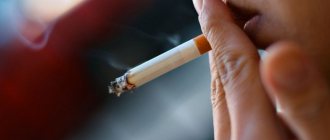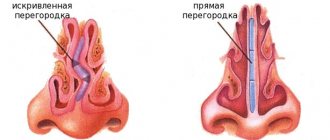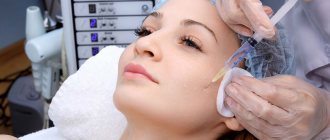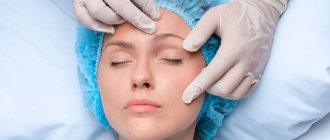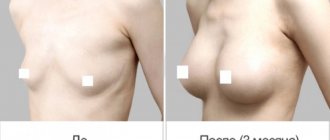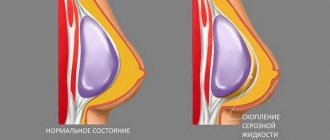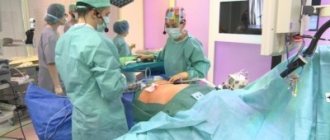Modern medicine has specialized technologies that allow the patient to avoid discomfort after septoplasty and breathe through the nose.
Author:
Gadzhiev Kamran Rafikovich
otolaryngologist, rhinosurgeon
Added information about general recommendations for the patient during the postoperative period.
The most common pathology of the ENT organs is a deviated nasal septum. No one thinks that even the slightest curvature can cause serious diseases, such as sinusitis, nasal polyps. Why is this happening? When the ENT organs are healthy, only clean and warm air enters the lower respiratory tract, since it is warmed and disinfected in the nasal cavity. With a deviated nasal septum, these functions are disrupted due to the fact that the air stream hits the curvature of the septum.
Correction of a deviated nasal septum is called septoplasty. This operation helps the patient return to normal and natural breathing. But, unfortunately, many patients try to avoid it and continue to live with a deviated septum, which leads to complications in the future. What worries people before surgery:
- How to breathe through your nose after surgery?
- will tampons be placed in the nose?
- How long will I need to stay in the hospital after the operation?
These questions stop the patient from making the decision to undergo surgery.
How is rehabilitation after septoplasty?
With the development of technology, septoplasty has ceased to be uncomfortable. The operation begins with the patient being given anesthesia, then the doctor uses an endoscope, through a small incision, to enter between the layers of the mucous membrane and straighten the septum.
During the rehabilitation period, technologies were also created that allow the patient to avoid unpleasant sensations and breathe through the nose. Intranasal septal splints according to Reiter or splints were created. They are made of soft silicone, as it does not cause any harm to the nasal cavity and is painlessly removed from it. The splints have a seven-sided shape, which completely follows the shape of the nasal septum at the site of the operation. The essence of splints is that they keep the septum in the midline. After the operation, while the patient is under anesthesia, a silicone splint is sewn on.
Splints come in different modifications. Depending on the shape of the nose, they can be either large or small. A tube can also be inserted between the silicone of the splint, through which the patient can breathe immediately after the operation. The septal splint stays in the nose for about 5-7 days, during which time the nasal septum takes its position.
Side effects – what are they, how long should they last, how to eliminate them?
Will your nostrils begin to breathe soon?
Non-breathing, blocked or poor breathing in one or both nostrils is the most common complaint after nasal surgery. When does the operated olfactory organ begin to breathe, how many days after plastic surgery will this happen? The timing of breathing recovery is always individual. In some patients, difficulty breathing in and out may persist even after a month.
The early rehabilitation period lasts three weeks - this is the same time after which breathing is restored in 75% of patients, and the nose can already breathe quite freely. Ideally, breathing should return to normal a few days after septoplasty.
During this time, breathing is always difficult and no emergency measures need to be taken; it is enough to strictly follow the rehabilitation plan prescribed by the doctor. To make your nose breathe faster, you can periodically:
- instill vasoconstrictor drops;
- apply cooling compresses.
If after two months breathing has not been restored and your nose is still stuffy, you should sound the alarm and contact a plastic surgeon. There is a high probability that errors were made during the operation.
Crusts - how to remove them?
This side effect is not pathological. Within two weeks you should:
- Gently lubricate the crusts on the mucous membrane with Vaseline, peach oil or butter;
- Irrigate the nasal cavity with sprays as prescribed by the doctor.
Bruises
The appearance of bruises under the eyes after septoplasty can be considered normal. They go away in 2-3 weeks. Most often, after 10 days it is quite possible to go to work, masking the bruises with foundation.
Swelling – when will it go down?
It is a natural symptom and normal for two weeks after the intervention. If the swelling has spread to the entire face and a week after the operation there is no tendency to reduce it, then we are talking about a serious complication.
Edema can be caused by:
- eating hot food;
- taking a hot bath;
- washing with hot water;
- sleeping without a pillow.
How to relieve swelling? The following manipulations will help:
- Maintaining bed rest.
- Applying compresses with ice.
- Taking medications that strengthen the walls of blood vessels.
- Physiotherapy.
- Humidifying the air in the room where the patient is.
Headache
This may be a reaction to anesthesia. The headache can even hurt simply from the excitement and overexertion suffered before the operation.
Headaches may be an allergic reaction to any medications.
In this case, a different treatment regimen is selected and antihistamines are prescribed.
During the rehabilitation period, it is recommended to avoid provoking factors that can cause headaches, namely:
- stress;
- physical activity;
- long exposure to the sun.
Discomfort in the throat
Pain in the throat is the result of minor damage to the mucous membrane. After 2-3 weeks they should go away. As prescribed by your doctor, you can:
- use softening lozenges;
- irrigate the oral cavity with special healing sprays.
The operation site hurts
Pain after surgery is absolutely natural and, nevertheless, it should subside within a week after the intervention. During this time, the patient takes painkillers.
It is acceptable to maintain mild discomfort. If after a week the pain does not go away, this is a signal that a pathological process is occurring in the body and you should seek advice from a specialist.
Temperature - how long does it remain normal?
The patient may have a fever for several days after surgery.
Normally, it should not rise above 38 degrees. A high temperature that persists for a week indicates the development of an inflammatory process. The cause of high temperature may be otitis or sinusitis , which the patient had even before septoplasty, inflammation of the ethmoid sinuses, or rotavirus infection.
In this situation, you should not take antipyretic drugs on your own; you should definitely consult a doctor.
Septal splints
Recently, septal splints or intranasal splints have become an integral part of operations on the nasal septum. For septoplasty, rhinoseptoplasty and closure of perforations of the nasal septum, the final stage of the operation is the installation of septal splints on both sides of the nasal septum.
The reason splints are so popular among surgeons is a number of advantages that improve the outcome of the operation, reduce the risks of postoperative complications and speed up the patient’s recovery.
The advantages of septal splints are reflected in the table
| Traditional septoplasty method | Septoplasty using septal splints | |
| Nasal discharge | After the operation, the mucous discharge in the nose and the remaining blood dry up. Crusts form in the nasal cavity, which adhere to the nasal mucosa and are difficult to remove. They also impair breathing and cause severe discomfort in the patient in the postoperative period. | Septal splints cover the entire mucous membrane of the nasal septum and prevent the formation of crusts on the mucous membrane of the nasal septum. And due to the fact that they are made of silicone, all the pathological contents in the nose do not find adhesion and are easily washed off with a nasal shower. |
| Swelling of the mucous membrane | After surgery, the nasal mucosa begins to swell and close the nasal passages due to surgical exposure. Because of this, the patient cannot breathe through his nose, he has to breathe through his mouth, and thus develops dry mouth, etc. | Silicone splints prevent the nasal mucosa from swelling and closing, as they are very flexible and quite elastic. And thanks to special channels, the patient does not have breathing problems after the operation. |
| Adhesions in the nose | Often, upon a second visit to the doctor, the patient is informed about the formation of adhesions in the nose (synechia). The reason for adhesions in the nose is that the mucous membrane of the nasal septum, due to swelling, begins to come into contact with the mucous membrane of the lateral (opposite) wall of the nose, as a result of which they stick together, and the patient faces additional surgery. | Being a barrier between mucous membranes, splints help to avoid this complication. |
| Re-displacement of the septum after surgery | High risk of displacement. | Splints, like a plaster cast, applied to a broken limb, keep the nasal septum strictly in the midline and give it additional support. Thus, splints help to avoid such complications as a secondary displaced nasal septum. |
| Nose bleed | Frequent nosebleeds. | By holding the nasal septum tightly in the midline, the splints compress the vessels and blood does not accumulate between the layers of the nasal septum mucosa. Thus, frequent complications such as nosebleeds or hematoma of the nasal septum do not occur with installed splints. |
| Tamponation | Mandatory packing. Tampons in the nose create additional discomfort. | It is possible to avoid packing of the nasal cavity. Due to this, the rehabilitation period for the patient is easier. But it should still be remembered that only the surgeon decides whether to pack the nasal cavity or not, depending on the circumstances after installing the splints. |
Rules of care
In the first few days after surgery, mechanical impact on the nose is prohibited. You need to be extremely careful when performing hygiene procedures.
Equally important during this period is compliance with the care specialist’s instructions while wearing retaining devices in the nasal cavity.
Splints
Splints in the nose are an integral part of the recovery period. These are special tires made of silicone. They help fix the septum in a new position and prevent it from moving. They are usually removed on the 4th day after installation. After this, the doctor tells the patient how to properly do nasal baths.
Tampons
They are made in the form of dense inserts, which also allow you to hold the nasal septum and prevent it from moving. Before installation, they are moistened in a solution of hemostatic agents and antibiotics. The tampons are removed from the nose 2-3 days after surgery.
Postoperative period
Nose pain
Often in the postoperative period, patients experience pain in the nose. This is due both to the surgical procedure itself and to the presence of tampons in the nose. If the pain is severe, the doctor may prescribe opioid-containing narcotic painkillers such as tramadol, promedol. Most often, patients themselves refuse opioid analgesics. In this case, doctors use non-steroidal anti-inflammatory drugs: ketorol, diclofenac, analgin. However, a contraindication to these drugs is the deterioration of blood clotting and an increased risk of postoperative bleeding, so doctors do not recommend using these drugs frequently, especially in the first days after surgery.
To reduce pain after septoplasty, it is recommended to raise the head of the bed if the patient is undergoing rehabilitation in a hospital. At home, you need to lie with your head elevated, using 2-3 pillows. It is also recommended to apply ice to the bridge of the nose and forehead for 5-10 minutes 2-3 times a day.
In the postoperative period, you should not touch your nose, especially avoid pressing on the tip of the nose. This can cause severe pain and will cause poor tissue healing in the surgical area. Also, trauma to the nose after septoplasty often causes a shift of the nasal septum to the side.
Antibiotics
During the rehabilitation period, antibiotics are prescribed to reduce the risk of infection. Usually these are penicillin antibiotics. It is necessary to strictly adhere to the duration and dose of antibiotics prescribed by the doctor.
Vasoconstrictors and nasal douche
The next day after removing the tampons, you will need to use vasoconstrictor nasal drops, for example, xylometazoline, Nazivin and saline solutions for the nose (Aqua-Lor, Dolphin). Vasoconstrictors are prescribed to reduce swelling in the nose and widen the nasal passages. This improves nasal patency during nasal shower with saline solutions. Saline solutions wash away mucus, congealed blood, and crusts from the nose, speeding up recovery. On average, vasoconstrictor drops and nasal douche are prescribed for 5-7 days.
General recommendations for the patient during the postoperative period
The postoperative period lasts for 3 weeks after surgery. At this time, the main thing is to speed up the metabolism in the body, which will speed up recovery. To do this, the patient is prescribed to drink plenty of fluids - up to 3 liters of fluid per day, and moderate walking - 3-4 hours during the day. However, you should not engage in physical exercise or strain yourself - physical activity is contraindicated during the entire rehabilitation period.
Edema
In the first days after surgery, severe swelling will interfere with normal nasal breathing. Fortunately, it remains strong for a week, and then gradually decreases, and by the end of the month it most often disappears completely. Every day the patient will feel that the nose is breathing better and better.
You can speed up the process by the following measures:
- keeping quiet
- using ice packs
- taking medications that strengthen the vascular wall and antiallergic drugs
- visiting physiotherapeutic procedures (UHF therapy)
- use of vasoconstrictor drops and nasal sprays
- indoor air humidification
In some cases, nasal swelling may persist for 6-8 or even 12 months after surgery, and may only occur under certain conditions (for example, in damp weather).
Result - when and what to expect?
Septoplasty is a plastic surgery to correct a deformed nasal septum. The essence is either the correction of cartilage or bone tissue, or their partial removal.
There are no external incisions; all manipulations are carried out through the nostrils. The operation, depending on the situation, is performed under general or local anesthesia (more information about how the operation is performed can be found in a separate article). The results after such a surgical intervention will be gradual.
Second day
- Breathing is difficult. Due to the forced intake of air through the mouth, it constantly feels dry.
- Post-operative tampons are placed in the patient's nose, and special tubes are inserted into the nose to facilitate breathing.
- A plaster is applied to the bridge of the nose, fixing the cartilage, which at this moment is very mobile and can shift with any careless movement.
- Some patients bleed, but the bleeding is minor.
- The anesthesia wears off and the patient begins to experience pain, to combat which painkillers are prescribed.
Fifth day
- The main pain goes away, swelling begins to subside.
- At this time, it is not recommended to wipe your nose or blow your nose.
- The nose can be cleaned with cotton swabs, removing clots of secretions.
A week after plastic surgery
- The plaster cast is removed and along with it the plaster adjacent to the skin.
- All external sutures are removed if the situation required them.
- An idea of the outlines of the new nose can be obtained just after the plaster is removed, but it should be borne in mind that all the details will finally be visible only after the completion of the rehabilitation period.
A month later
- Bruises, swelling, spots and swelling finally disappear.
- The patient may experience nasal numbness and an oily sheen at the tip of the nose. This occurs due to the activation of the sebaceous glands.
Final result
The final result of the operation can be assessed only after six months; many patients experience slight changes in the nose within three years. The need for a repeat operation can be determined only after six months, and it can be done after a year.
You will learn from this material how it goes and how long the recovery period after rhinoplasty can last.
Possible complications after septoplasty of the nasal septum
Septoplasty is a serious operation that involves correction of the nasal septum. During the process, the surgeon touches several types of tissue, and each body perceives the intervention differently. Consequently, complications are possible.
Complications after nasal septoplasty are rare, but no one is immune from them. They appear in different forms and are eliminated in a certain way.
What causes complications?
There are a number of risk factors that cause unpleasant consequences after septoplasty:
- Failure to comply with the rules for performing the operation. This is what they encounter after turning to illiterate specialists.
- Inflammation of the mucous membrane. This applies to the acute form and remission.
- Failure to comply with hygienic conditions during surgery. Infection is a consequence.
- Serious illnesses. Some diseases make themselves felt after surgery.
- Failure to comply with the rules of preparation before septoplasty. Certain manipulations are prohibited before surgery.
- Failure to follow the technique for changing dressings. This applies to the early rehabilitation period (3 days after septoplasty).
Types of consequences
The main complications after septoplasty of the nasal septum and how they manifest themselves:
- Bleeding. There are many vessels and capillaries in the nose area. Sometimes bleeding occurs both during the operation and during the rehabilitation period. After bleeding, dark crusts come off.
- Loss of sensation and smell after septoplasty. Nerves are damaged during surgery. Because of this, tissue numbness occurs.
- Hematomas and swelling. The hematoma after septoplasty is sometimes voluminous in outline. How long the swelling lasts after surgery determines the patient’s attitude towards the rehabilitation process and the characteristics of his body.
- Injuries to the mucous membrane. Its deformation is inevitable, but in rare cases, special therapy is prescribed for recovery purposes.
- Synechiae. After surgery, adhesions appear. The nose breathes very rarely or one nostril does not breathe.
- Purulent sinusitis. Green snot after septoplasty is a characteristic symptom of the pathology.
- Nose contours that do not meet expectations. For example, when the tip of the nose droops or the septum remains crooked. The reason is the incompetence of the doctor or improper care.
- Perichondritis. A complication occurs after the penetration of microorganisms that provoke an infection, and the temperature rises.
- Abscess of the nasal septum. Patients complain that their head, nose and neck hurt after septoplasty when a complication occurs. The only way to get rid of the disease is surgery.
- Toothache. If your teeth hurt after septoplasty, it means that branches of the nasopalatine nerve were affected during the operation. This usually goes away after a month.
Prevention of complications
Follow the rules so that unpleasant consequences do not worsen the rehabilitation period after nasal septoplasty:
- Avoid cigarettes and alcohol-containing drinks 30 days before the procedure.
- Follow your diet. Avoid sweets, chocolate, fatty and fried foods a week or two before surgery.
- Do the dressings correctly. Use antiseptics and sterile dressings. These include hydrogen peroxide and furatsilin.
- Use antibiotics if there are signs of infection. Take tablets or inject antimicrobial medications for 5 days. Antibiotics are selected by the doctor.
- If necessary, use agents that increase blood clotting. Aminocaproic acid is suitable.
- Use medications that speed up the healing process. These include anti-edema medications (heparin ointment, badyaga) and anti-inflammatory medications (Levomekol).
- Check for contraindications before surgery. Get tested and consult with doctors.
https://youtube.com/watch?v=4sBlbkru3wM
Septoplasty methods
During surgery, the nasal septum is straightened and centered.
Previously, a deviated septum was removed completely, but this caused a lot of complications - for example, there were cases when a patient’s septum sagged after septoplasty, etc.
Some doctors still practice this method today, although this surgical technique is considered outdated.
Modern plastic surgeons strive to preserve the elements of the septum as much as possible as a support for the external nose.
Septoplasty is often performed simultaneously with rhinoplasty.
Complications during septum plastic surgery
Adhesions (synechiae)
Synechiae grow together between the walls of blood vessels and block the lumen of the nasal cavity, which leads to difficulty in the flow of air. Adhesions increase the risk of infection.
Only surgical intervention can help, during which the adhesions are removed with a scalpel or laser, after which a special splint is installed to prevent the re-formation of adhesions.
Bleeding
Normally, heavy bleeding should not be observed during the rehabilitation period. A slight discharge of blood along with other fluids is acceptable. Excessive bleeding may be caused by weak blood vessels in the nasal cavity.
Bleeding can result from:
- Physical exercise.
- High blood pressure.
- Sneezing with a closed mouth in the first postoperative days.
- Prolonged exposure to the sun.
- Incorrect nose treatment.
To eliminate bleeding, vasoconstrictor drugs are prescribed.
Pus
A festering suture on the nose is most often a consequence of the inflammatory process.
You should immediately consult a doctor, as any infection slows down or completely stops the healing process, and can also lead to irreversible consequences.
The doctor will treat the cavity with disinfectants and give recommendations for further care of the nasal cavity.
Nasal mucus flows
This occurs due to the fact that the normal functioning of the mucous membrane has been disrupted. There is no need to take emergency measures. Over time, these phenomena will pass as soon as the functioning of the nasal mucosa is restored.
Green discharge, for example, is not always a sign of incipient sinusitis. They may simply be an indicator that the immune system is actively fighting off attacks in the postoperative period.
Ichor
Prolonged discharge of ichor indicates that the suture is not healing well. The problem may be individual in nature, for example, if the patient has poor blood clotting, or it may be a signal that the stitches were placed incorrectly or were not treated properly.
When faced with such a problem, you should definitely consult a doctor for diagnosis and prescription of healing ointments and medications.
Curvature
Various anatomical changes after surgery to correct the nasal septum are an aesthetic defect and can serve as a basis for disruption of natural breathing. If the olfactory organ has become crooked, a secondary operation will be required to correct the situation.
Types of septoplasty
Correction of the nasal septum may require correction of only the bone or cartilage portion. The selection of an effective technique largely depends on the nature of the curvature.
- Endoscopic septoplasty is aimed at giving the nasal septum a central position and correct shape while maximizing the preservation of its tissues. To provide access, the doctor makes incisions on the inner surface of the nose.
- Laser septoplasty is the latest method in which the doctor will correct the shape and position of the nasal septum with minimal blood loss and high precision. The operation is performed through minimal incisions, the mucous membrane heals in the shortest possible time, and the risk of infection is extremely low.
- Ultrasonic septoplasty is performed using an ultrasonic knife, which cuts tissue, coagulating blood vessels, which makes the operation bloodless and shortens the recovery period. Ultrasound surgery eliminates obvious septal defects – spines and ridges.
Order of conduct
An otolaryngologist can recommend septoplasty, who will analyze the symptoms and complaints and evaluate the clinical picture.
Before surgery, the body should be examined to minimize the risks of complications and identify contraindications.
These tests are mandatory before septoplasty:
- X-ray,
- Fluorography,
- Clinical, biochemical blood test,
- Analysis of urine,
- Analysis for Rh factor and blood group,
- Blood test for hepatitis, syphilis, HIV,
- Prothrombin analysis.
A consultation is also scheduled with a plastic surgeon who will conduct the operation and an anesthesiologist to select the type of anesthesia and medications.
Progress and technique of septoplasty:
- Anesthesia (general or local) is performed.
- Incisions are made in the mucous membrane to gain access to the cartilage tissue.
- Soft tissues peel off.
- The curvatures of the cartilaginous tissues are removed, for which in some cases the cartilage tissues are removed.
- If extracted, the cartilages are reimplanted after correction.
- Stitches are applied.
- Turundas are inserted into the nasal passages.
- A fixing bandage is applied.

